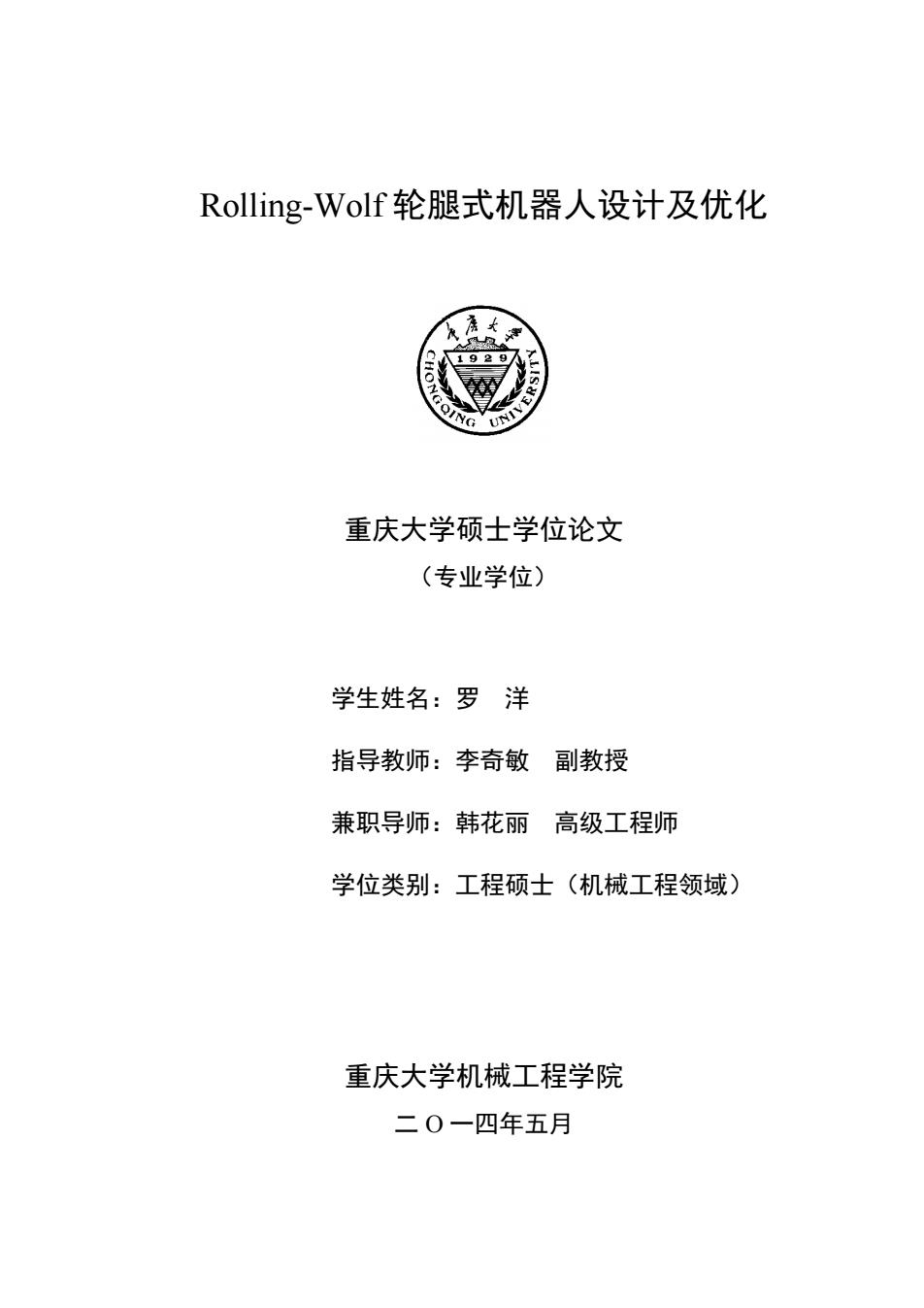
Rolling-.Wolf轮腿式机器人设计及优化 UNI 重庆大学硕士学位论文 (专业学位) 学生姓名:罗洋 指导教师:李奇敏 副教授 兼职导师:韩花丽 高级工程师 学位类别:工程硕士(机械工程领域) 重庆大学机械工程学院 二0一四年五月
Rolling-Wolf 轮腿式机器人设计及优化 重庆大学硕士学位论文 (专业学位) 学生姓名:罗 洋 指导教师:李奇敏 副教授 兼职导师:韩花丽 高级工程师 学位类别:工程硕士(机械工程领域) 重庆大学机械工程学院 二 O 一四年五月

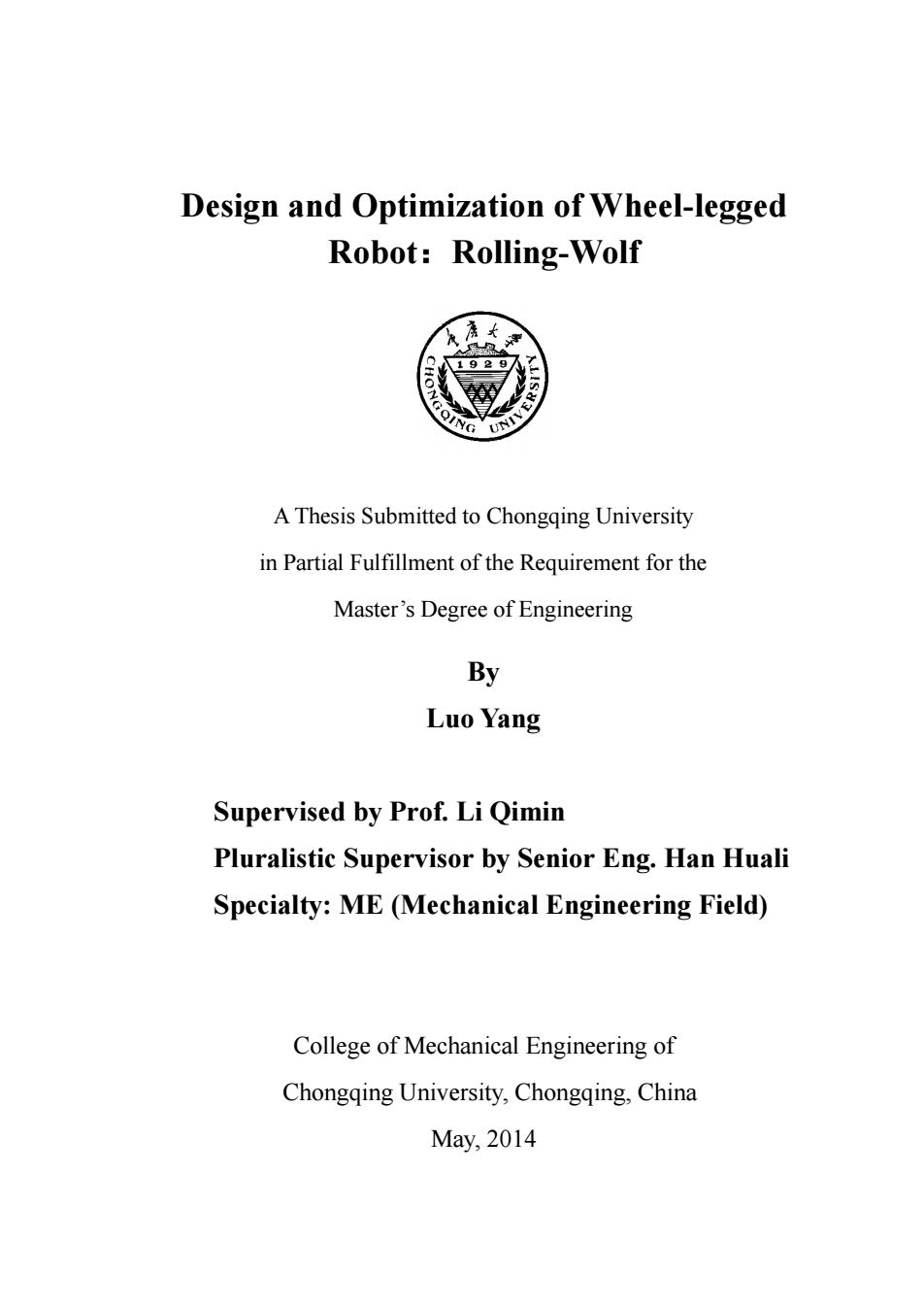
Design and Optimization of Wheel-legged Robot:Rolling-Wolf QING A Thesis Submitted to Chongqing University in Partial Fulfillment of the Requirement for the Master's Degree of Engineering By Luo Yang Supervised by Prof.Li Qimin Pluralistic Supervisor by Senior Eng.Han Huali Specialty:ME (Mechanical Engineering Field) College of Mechanical Engineering of Chongqing University,Chongqing,China May,2014
Design and Optimization of Wheel-legged Robot:Rolling-Wolf A Thesis Submitted to Chongqing University in Partial Fulfillment of the Requirement for the Master’s Degree of Engineering By Luo Yang Supervised by Prof. Li Qimin Pluralistic Supervisor by Senior Eng. Han Huali Specialty: ME (Mechanical Engineering Field) College of Mechanical Engineering of Chongqing University, Chongqing, China May, 2014

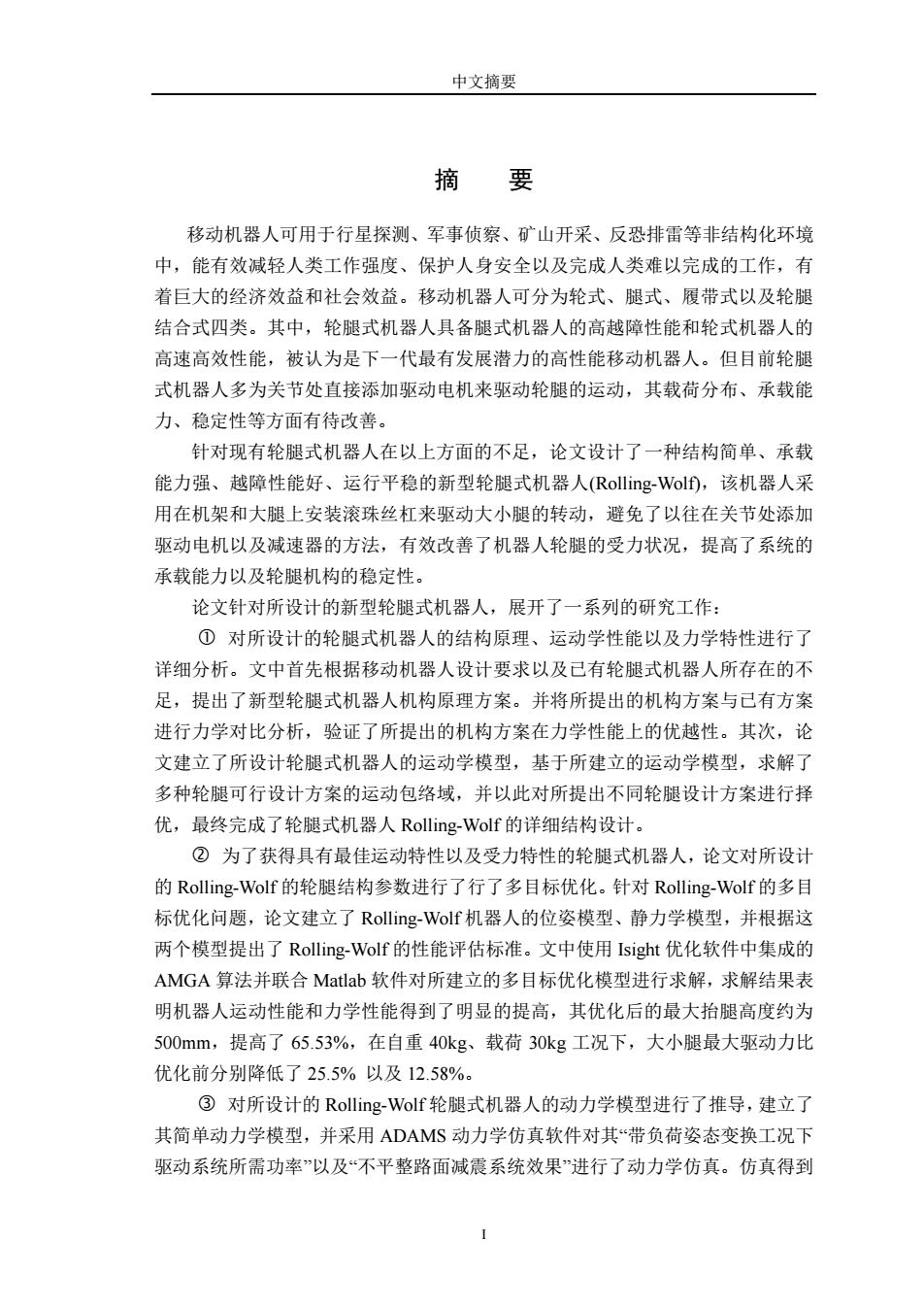
中文摘要 摘 要 移动机器人可用于行星探测、军事侦察、矿山开采、反恐排雷等非结构化环境 中,能有效减轻人类工作强度、保护人身安全以及完成人类难以完成的工作,有 着巨大的经济效益和社会效益。移动机器人可分为轮式、腿式、履带式以及轮腿 结合式四类。其中,轮腿式机器人具备腿式机器人的高越障性能和轮式机器人的 高速高效性能,被认为是下一代最有发展潜力的高性能移动机器人。但目前轮腿 式机器人多为关节处直接添加驱动电机来驱动轮腿的运动,其载荷分布、承载能 力、稳定性等方面有待改善。 针对现有轮腿式机器人在以上方面的不足,论文设计了一种结构简单、承载 能力强、越障性能好、运行平稳的新型轮腿式机器人(Rolling-Wolf),该机器人采 用在机架和大腿上安装滚珠丝杠来驱动大小腿的转动,避免了以往在关节处添加 驱动电机以及减速器的方法,有效改善了机器人轮腿的受力状况,提高了系统的 承载能力以及轮腿机构的稳定性。 论文针对所设计的新型轮腿式机器人,展开了一系列的研究工作: ①对所设计的轮腿式机器人的结构原理、运动学性能以及力学特性进行了 详细分析。文中首先根据移动机器人设计要求以及已有轮腿式机器人所存在的不 足,提出了新型轮腿式机器人机构原理方案。并将所提出的机构方案与己有方案 进行力学对比分析,验证了所提出的机构方案在力学性能上的优越性。其次,论 文建立了所设计轮腿式机器人的运动学模型,基于所建立的运动学模型,求解了 多种轮腿可行设计方案的运动包络域,并以此对所提出不同轮腿设计方案进行择 优,最终完成了轮腿式机器人Rolling-Wolf的详细结构设计。 ②为了获得具有最佳运动特性以及受力特性的轮腿式机器人,论文对所设计 的Rolling-Wolf的轮腿结构参数进行了行了多目标优化。针对Rolling-Wolf的多目 标优化问题,论文建立了Rolling-Wolf机器人的位姿模型、静力学模型,并根据这 两个模型提出了Rolling-Wolf的性能评估标准。文中使用Isight优化软件中集成的 AMGA算法并联合Matlab软件对所建立的多目标优化模型进行求解,求解结果表 明机器人运动性能和力学性能得到了明显的提高,其优化后的最大抬腿高度约为 500mm,提高了65.53%,在自重40kg、载荷30kg工况下,大小腿最大驱动力比 优化前分别降低了25.5%以及12.58%。 ③对所设计的Rolling-Wolf轮腿式机器人的动力学模型进行了推导,建立了 其简单动力学模型,并采用ADAMS动力学仿真软件对其“带负荷姿态变换工况下 驱动系统所需功率”以及“不平整路面减震系统效果”进行了动力学仿真。仿真得到
中文摘要 I 摘 要 移动机器人可用于行星探测、军事侦察、矿山开采、反恐排雷等非结构化环境 中,能有效减轻人类工作强度、保护人身安全以及完成人类难以完成的工作,有 着巨大的经济效益和社会效益。移动机器人可分为轮式、腿式、履带式以及轮腿 结合式四类。其中,轮腿式机器人具备腿式机器人的高越障性能和轮式机器人的 高速高效性能,被认为是下一代最有发展潜力的高性能移动机器人。但目前轮腿 式机器人多为关节处直接添加驱动电机来驱动轮腿的运动,其载荷分布、承载能 力、稳定性等方面有待改善。 针对现有轮腿式机器人在以上方面的不足,论文设计了一种结构简单、承载 能力强、越障性能好、运行平稳的新型轮腿式机器人(Rolling-Wolf),该机器人采 用在机架和大腿上安装滚珠丝杠来驱动大小腿的转动,避免了以往在关节处添加 驱动电机以及减速器的方法,有效改善了机器人轮腿的受力状况,提高了系统的 承载能力以及轮腿机构的稳定性。 论文针对所设计的新型轮腿式机器人,展开了一系列的研究工作: 对所设计的轮腿式机器人的结构原理、运动学性能以及力学特性进行了 详细分析。文中首先根据移动机器人设计要求以及已有轮腿式机器人所存在的不 足,提出了新型轮腿式机器人机构原理方案。并将所提出的机构方案与已有方案 进行力学对比分析,验证了所提出的机构方案在力学性能上的优越性。其次,论 文建立了所设计轮腿式机器人的运动学模型,基于所建立的运动学模型,求解了 多种轮腿可行设计方案的运动包络域,并以此对所提出不同轮腿设计方案进行择 优,最终完成了轮腿式机器人 Rolling-Wolf 的详细结构设计。 为了获得具有最佳运动特性以及受力特性的轮腿式机器人,论文对所设计 的 Rolling-Wolf 的轮腿结构参数进行了行了多目标优化。针对 Rolling-Wolf 的多目 标优化问题,论文建立了 Rolling-Wolf 机器人的位姿模型、静力学模型,并根据这 两个模型提出了 Rolling-Wolf 的性能评估标准。文中使用 Isight 优化软件中集成的 AMGA 算法并联合 Matlab 软件对所建立的多目标优化模型进行求解,求解结果表 明机器人运动性能和力学性能得到了明显的提高,其优化后的最大抬腿高度约为 500mm,提高了 65.53%,在自重 40kg、载荷 30kg 工况下,大小腿最大驱动力比 优化前分别降低了 25.5% 以及 12.58%。 对所设计的 Rolling-Wolf 轮腿式机器人的动力学模型进行了推导,建立了 其简单动力学模型,并采用 ADAMS 动力学仿真软件对其―带负荷姿态变换工况下 驱动系统所需功率‖以及―不平整路面减震系统效果‖进行了动力学仿真。仿真得到

重庆大学硕士学位论文 了机器人各种工况下所需扭矩及功率,为样机制造提供参考。此外有无减震系统 对比仿真结果表明:没有减震系统的机器人机身和驱动滑块在不平整路面滚动时 将受到剧烈的冲击力,且远远高于有减震系统时的值。该仿真结果验证了轮腿式 机器人设计弹簧减震系统能有效减少机身振动和驱动系统的冲击力,为 Rolling-Wolf及其他移动机器人减震设计提供参考。 ④完成了Rolling-Wolf轮腿式机器人控制系统的软硬件设计。针对轮腿式机 器人对控制系统稳定性要求高、响应速度快的特点,设计了基于STM32F103系列 微控制器的多级分布式控制系统。为了提高系统可靠性以及响应速度,控制系统 内部设计了一种具有执行优先级和任务抢断功能的多线程任务调度器来提高机器 人运行效率。控制系统实验结果表明所设计的控制系统运行稳定、响应快,达到 了设计指标的要求。 ⑤为了提高机器人在非结构化环境中的适应性,对其姿态自适应模式下的姿 态调整算法进行了设计。所设计的姿态自适应模式下的姿态调整算法采取离散取 值法,即将轮心在该模式下的高度坐标值进行在预定轨迹上1mm离散化取值,根 据每一个离散高度求得相应的大小腿角度,并将这些数据存储于数据库中,使用 时根据计算出的轮心所需高度(取整后),在数据库中调取相应的大小腿转角。该 方法有效提高了机器人姿态变换速度,避免了轮腿姿态变化时逆运动学求解结果 的不唯一性,有效减轻了控制器的数据运算量。原型机实验测试结果表明:所设 计的自适应姿态算法在车身发生倾斜时,能根据传感器参数变化完成对自身姿态 的修正,验证了算法的正确性。 关键词:轮腿,混合移动系统,机器人,机器人控制,步态规划
重庆大学硕士学位论文 II 了机器人各种工况下所需扭矩及功率,为样机制造提供参考。此外有无减震系统 对比仿真结果表明:没有减震系统的机器人机身和驱动滑块在不平整路面滚动时 将受到剧烈的冲击力,且远远高于有减震系统时的值。该仿真结果验证了轮腿式 机器人设计弹簧减震系统能有效减少机身振动和驱动系统的冲击力 ,为 Rolling-Wolf 及其他移动机器人减震设计提供参考。 完成了 Rolling-Wolf 轮腿式机器人控制系统的软硬件设计。针对轮腿式机 器人对控制系统稳定性要求高、响应速度快的特点,设计了基于 STM32F103 系列 微控制器的多级分布式控制系统。为了提高系统可靠性以及响应速度,控制系统 内部设计了一种具有执行优先级和任务抢断功能的多线程任务调度器来提高机器 人运行效率。控制系统实验结果表明所设计的控制系统运行稳定、响应快,达到 了设计指标的要求。 为了提高机器人在非结构化环境中的适应性,对其姿态自适应模式下的姿 态调整算法进行了设计。所设计的姿态自适应模式下的姿态调整算法采取离散取 值法,即将轮心在该模式下的高度坐标值进行在预定轨迹上 1mm 离散化取值,根 据每一个离散高度求得相应的大小腿角度,并将这些数据存储于数据库中,使用 时根据计算出的轮心所需高度(取整后),在数据库中调取相应的大小腿转角。该 方法有效提高了机器人姿态变换速度,避免了轮腿姿态变化时逆运动学求解结果 的不唯一性,有效减轻了控制器的数据运算量。原型机实验测试结果表明:所设 计的自适应姿态算法在车身发生倾斜时,能根据传感器参数变化完成对自身姿态 的修正,验证了算法的正确性。 关键词:轮腿,混合移动系统,机器人,机器人控制,步态规划
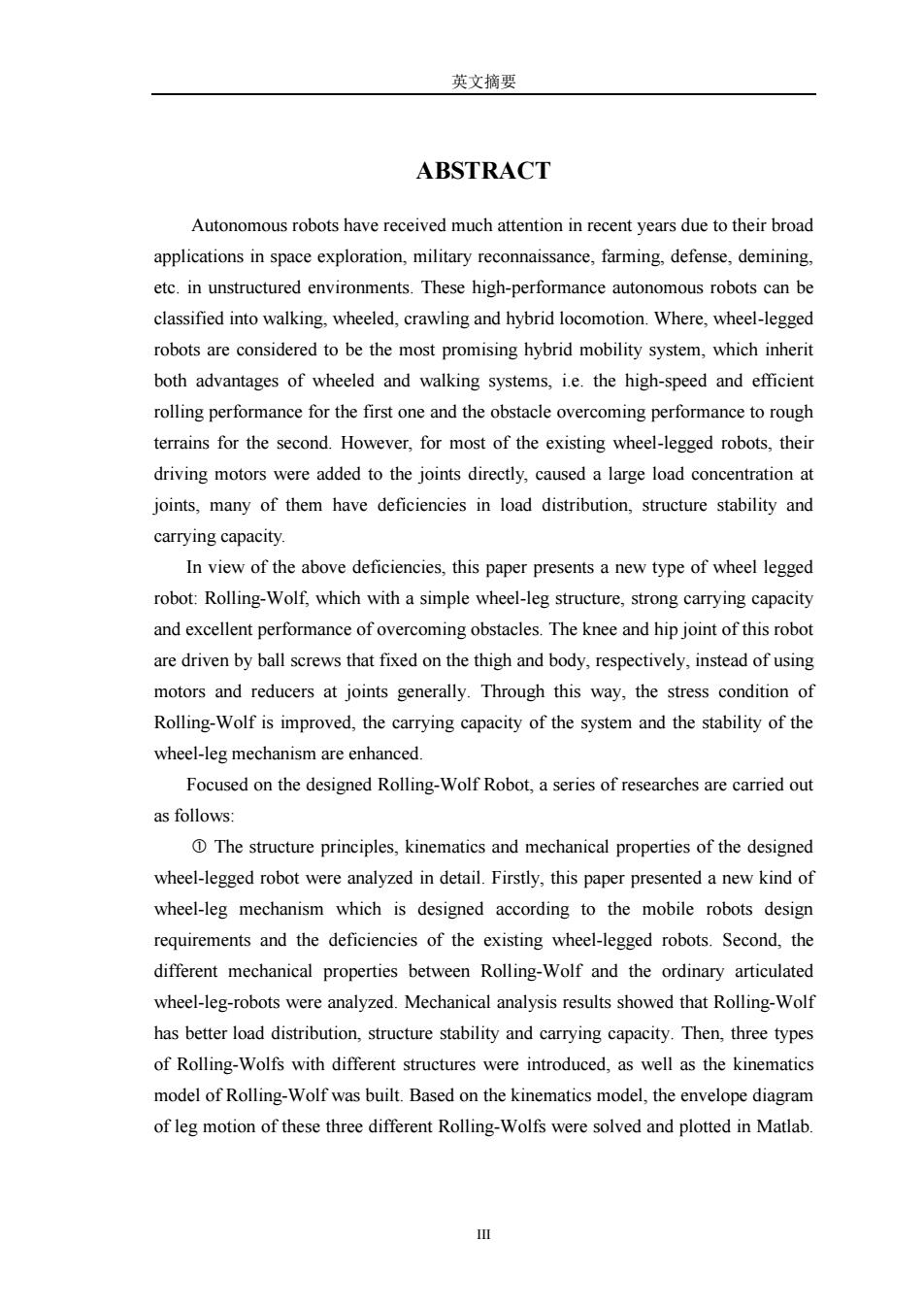
英文摘要 ABSTRACT Autonomous robots have received much attention in recent years due to their broad applications in space exploration,military reconnaissance,farming,defense,demining, etc.in unstructured environments.These high-performance autonomous robots can be classified into walking,wheeled,crawling and hybrid locomotion.Where,wheel-legged robots are considered to be the most promising hybrid mobility system,which inherit both advantages of wheeled and walking systems,i.e.the high-speed and efficient rolling performance for the first one and the obstacle overcoming performance to rough terrains for the second.However,for most of the existing wheel-legged robots,their driving motors were added to the joints directly,caused a large load concentration at joints,many of them have deficiencies in load distribution,structure stability and carrying capacity. In view of the above deficiencies,this paper presents a new type of wheel legged robot:Rolling-Wolf,which with a simple wheel-leg structure,strong carrying capacity and excellent performance of overcoming obstacles.The knee and hip joint of this robot are driven by ball screws that fixed on the thigh and body,respectively,instead of using motors and reducers at joints generally.Through this way,the stress condition of Rolling-Wolf is improved,the carrying capacity of the system and the stability of the wheel-leg mechanism are enhanced. Focused on the designed Rolling-Wolf Robot,a series of researches are carried out as follows: O The structure principles,kinematics and mechanical properties of the designed wheel-legged robot were analyzed in detail.Firstly,this paper presented a new kind of wheel-leg mechanism which is designed according to the mobile robots design requirements and the deficiencies of the existing wheel-legged robots.Second,the different mechanical properties between Rolling-Wolf and the ordinary articulated wheel-leg-robots were analyzed.Mechanical analysis results showed that Rolling-Wolf has better load distribution,structure stability and carrying capacity.Then,three types of Rolling-Wolfs with different structures were introduced,as well as the kinematics model of Rolling-Wolf was built.Based on the kinematics model,the envelope diagram of leg motion of these three different Rolling-Wolfs were solved and plotted in Matlab. Ⅲ
英文摘要 III ABSTRACT Autonomous robots have received much attention in recent years due to their broad applications in space exploration, military reconnaissance, farming, defense, demining, etc. in unstructured environments. These high-performance autonomous robots can be classified into walking, wheeled, crawling and hybrid locomotion. Where, wheel-legged robots are considered to be the most promising hybrid mobility system, which inherit both advantages of wheeled and walking systems, i.e. the high-speed and efficient rolling performance for the first one and the obstacle overcoming performance to rough terrains for the second. However, for most of the existing wheel-legged robots, their driving motors were added to the joints directly, caused a large load concentration at joints, many of them have deficiencies in load distribution, structure stability and carrying capacity. In view of the above deficiencies, this paper presents a new type of wheel legged robot: Rolling-Wolf, which with a simple wheel-leg structure, strong carrying capacity and excellent performance of overcoming obstacles. The knee and hip joint of this robot are driven by ball screws that fixed on the thigh and body, respectively, instead of using motors and reducers at joints generally. Through this way, the stress condition of Rolling-Wolf is improved, the carrying capacity of the system and the stability of the wheel-leg mechanism are enhanced. Focused on the designed Rolling-Wolf Robot, a series of researches are carried out as follows: The structure principles, kinematics and mechanical properties of the designed wheel-legged robot were analyzed in detail. Firstly, this paper presented a new kind of wheel-leg mechanism which is designed according to the mobile robots design requirements and the deficiencies of the existing wheel-legged robots. Second, the different mechanical properties between Rolling-Wolf and the ordinary articulated wheel-leg-robots were analyzed. Mechanical analysis results showed that Rolling-Wolf has better load distribution, structure stability and carrying capacity. Then, three types of Rolling-Wolfs with different structures were introduced, as well as the kinematics model of Rolling-Wolf was built. Based on the kinematics model, the envelope diagram of leg motion of these three different Rolling-Wolfs were solved and plotted in Matlab
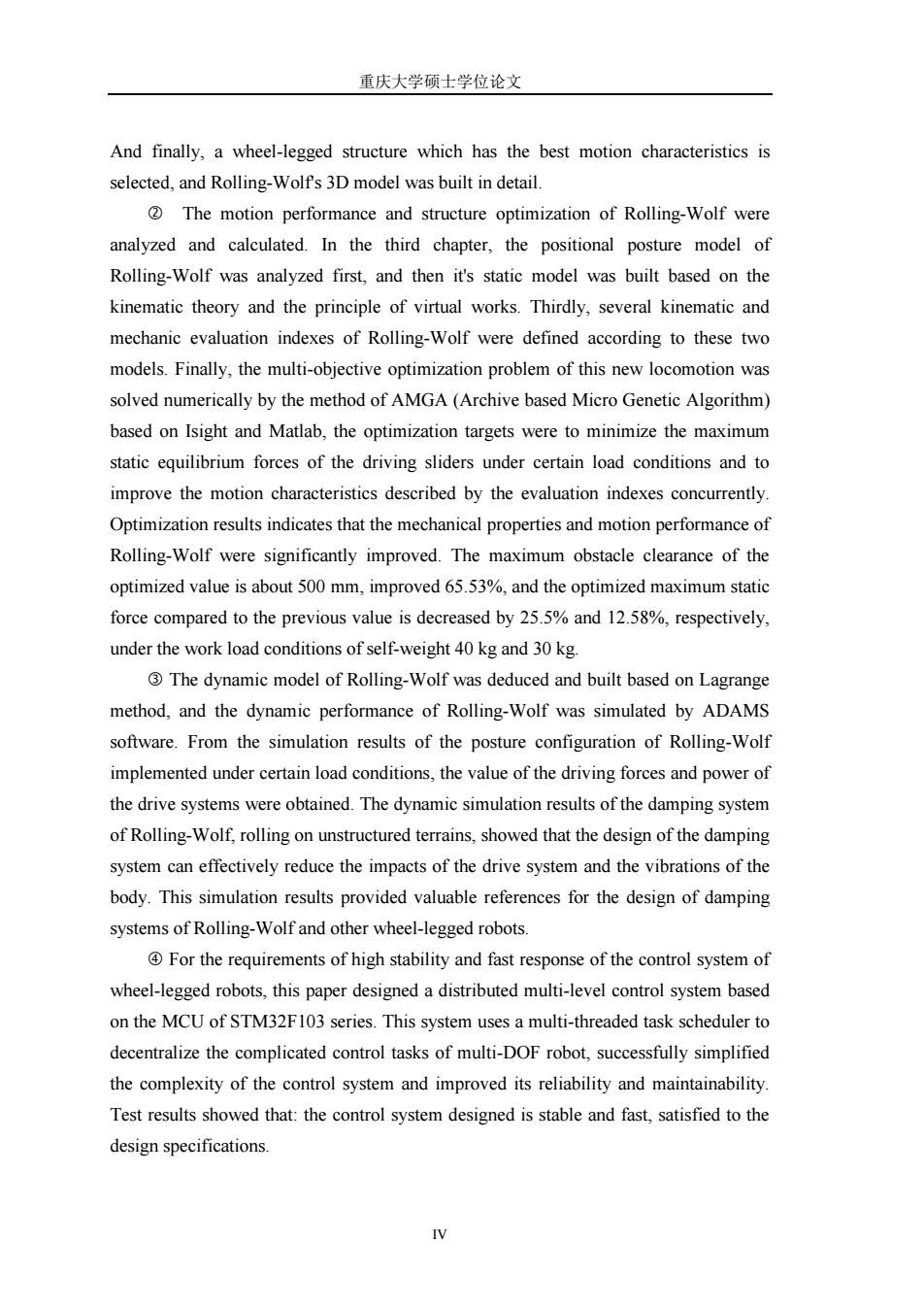
重庆大学硕士学位论文 And finally,a wheel-legged structure which has the best motion characteristics is selected,and Rolling-Wolfs 3D model was built in detail. 2 The motion performance and structure optimization of Rolling-Wolf were analyzed and calculated.In the third chapter,the positional posture model of Rolling-Wolf was analyzed first,and then it's static model was built based on the kinematic theory and the principle of virtual works.Thirdly,several kinematic and mechanic evaluation indexes of Rolling-Wolf were defined according to these two models.Finally,the multi-objective optimization problem of this new locomotion was solved numerically by the method of AMGA (Archive based Micro Genetic Algorithm) based on Isight and Matlab,the optimization targets were to minimize the maximum static equilibrium forces of the driving sliders under certain load conditions and to improve the motion characteristics described by the evaluation indexes concurrently. Optimization results indicates that the mechanical properties and motion performance of Rolling-Wolf were significantly improved.The maximum obstacle clearance of the optimized value is about 500 mm,improved 65.53%,and the optimized maximum static force compared to the previous value is decreased by 25.5%and 12.58%,respectively, under the work load conditions of self-weight 40 kg and 30 kg. 3 The dynamic model of Rolling-Wolf was deduced and built based on Lagrange method,and the dynamic performance of Rolling-Wolf was simulated by ADAMS software.From the simulation results of the posture configuration of Rolling-Wolf implemented under certain load conditions,the value of the driving forces and power of the drive systems were obtained.The dynamic simulation results of the damping system of Rolling-Wolf,rolling on unstructured terrains,showed that the design of the damping system can effectively reduce the impacts of the drive system and the vibrations of the body.This simulation results provided valuable references for the design of damping systems of Rolling-Wolf and other wheel-legged robots. For the requirements of high stability and fast response of the control system of wheel-legged robots,this paper designed a distributed multi-level control system based on the MCU of STM32F103 series.This system uses a multi-threaded task scheduler to decentralize the complicated control tasks of multi-DOF robot,successfully simplified the complexity of the control system and improved its reliability and maintainability. Test results showed that:the control system designed is stable and fast,satisfied to the design specifications
重庆大学硕士学位论文 IV And finally, a wheel-legged structure which has the best motion characteristics is selected, and Rolling-Wolf's 3D model was built in detail. The motion performance and structure optimization of Rolling-Wolf were analyzed and calculated. In the third chapter, the positional posture model of Rolling-Wolf was analyzed first, and then it's static model was built based on the kinematic theory and the principle of virtual works. Thirdly, several kinematic and mechanic evaluation indexes of Rolling-Wolf were defined according to these two models. Finally, the multi-objective optimization problem of this new locomotion was solved numerically by the method of AMGA (Archive based Micro Genetic Algorithm) based on Isight and Matlab, the optimization targets were to minimize the maximum static equilibrium forces of the driving sliders under certain load conditions and to improve the motion characteristics described by the evaluation indexes concurrently. Optimization results indicates that the mechanical properties and motion performance of Rolling-Wolf were significantly improved. The maximum obstacle clearance of the optimized value is about 500 mm, improved 65.53%, and the optimized maximum static force compared to the previous value is decreased by 25.5% and 12.58%, respectively, under the work load conditions of self-weight 40 kg and 30 kg. The dynamic model of Rolling-Wolf was deduced and built based on Lagrange method, and the dynamic performance of Rolling-Wolf was simulated by ADAMS software. From the simulation results of the posture configuration of Rolling-Wolf implemented under certain load conditions, the value of the driving forces and power of the drive systems were obtained. The dynamic simulation results of the damping system of Rolling-Wolf, rolling on unstructured terrains, showed that the design of the damping system can effectively reduce the impacts of the drive system and the vibrations of the body. This simulation results provided valuable references for the design of damping systems of Rolling-Wolf and other wheel-legged robots. For the requirements of high stability and fast response of the control system of wheel-legged robots, this paper designed a distributed multi-level control system based on the MCU of STM32F103 series. This system uses a multi-threaded task scheduler to decentralize the complicated control tasks of multi-DOF robot, successfully simplified the complexity of the control system and improved its reliability and maintainability. Test results showed that: the control system designed is stable and fast, satisfied to the design specifications
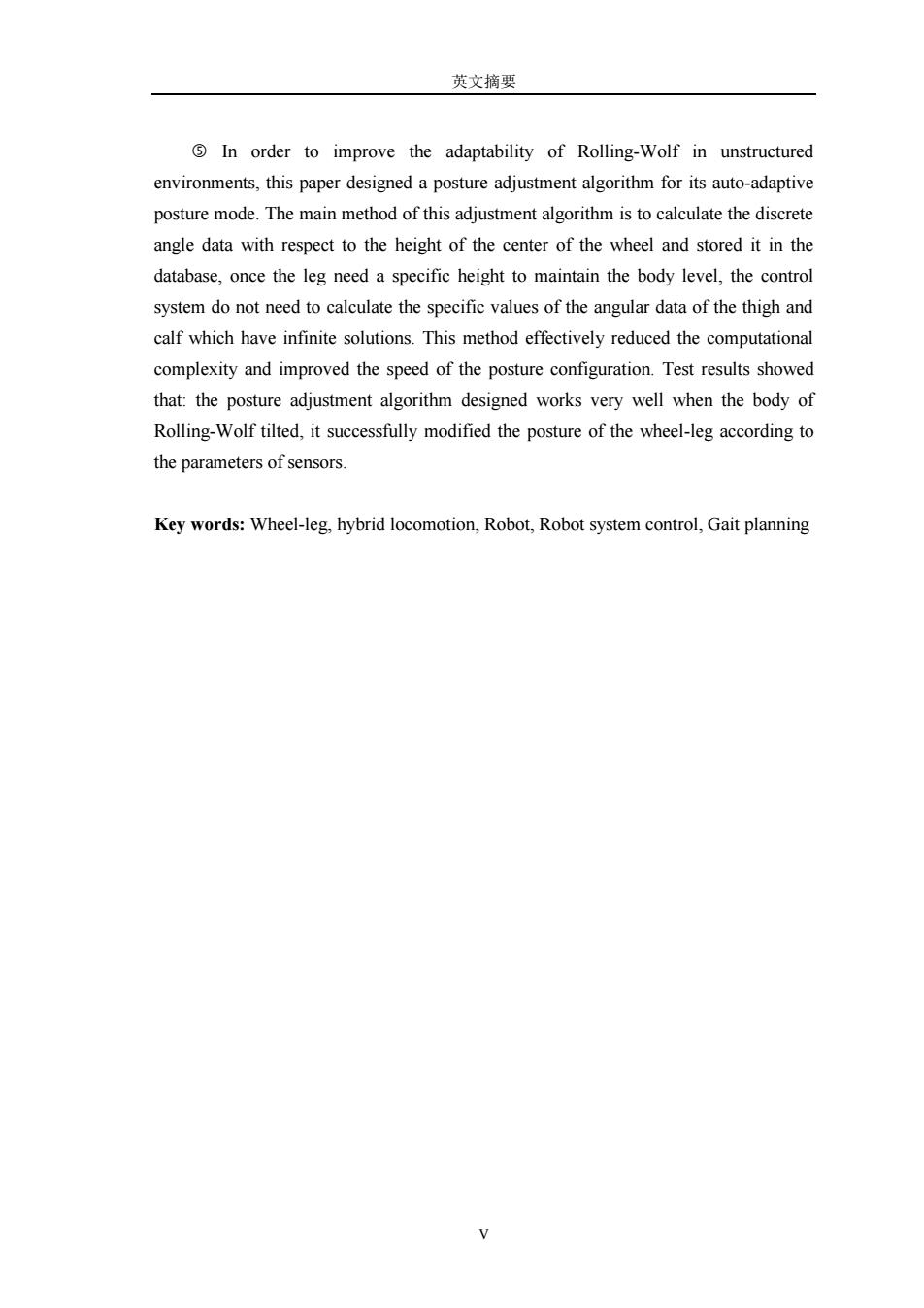
英文摘要 In order to improve the adaptability of Rolling-Wolf in unstructured environments,this paper designed a posture adjustment algorithm for its auto-adaptive posture mode.The main method of this adjustment algorithm is to calculate the discrete angle data with respect to the height of the center of the wheel and stored it in the database,once the leg need a specific height to maintain the body level,the control system do not need to calculate the specific values of the angular data of the thigh and calf which have infinite solutions.This method effectively reduced the computational complexity and improved the speed of the posture configuration.Test results showed that:the posture adjustment algorithm designed works very well when the body of Rolling-Wolf tilted,it successfully modified the posture of the wheel-leg according to the parameters of sensors. Key words:Wheel-leg,hybrid locomotion,Robot,Robot system control,Gait planning
英文摘要 V In order to improve the adaptability of Rolling-Wolf in unstructured environments, this paper designed a posture adjustment algorithm for its auto-adaptive posture mode. The main method of this adjustment algorithm is to calculate the discrete angle data with respect to the height of the center of the wheel and stored it in the database, once the leg need a specific height to maintain the body level, the control system do not need to calculate the specific values of the angular data of the thigh and calf which have infinite solutions. This method effectively reduced the computational complexity and improved the speed of the posture configuration. Test results showed that: the posture adjustment algorithm designed works very well when the body of Rolling-Wolf tilted, it successfully modified the posture of the wheel-leg according to the parameters of sensors. Key words: Wheel-leg, hybrid locomotion, Robot, Robot system control, Gait planning

重庆大学硕士学位论文 VI
重庆大学硕士学位论文 VI